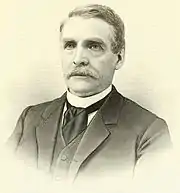John Martin | |
|---|---|
 | |
| Born | August 18, 1820 Peacham, Vermont, United States |
| Died | May 25, 1905 (aged 84) Hennepin County, Minnesota, United States |
| Occupation(s) | Steamboat captain, businessperson, lumberman, miller philanthropist |
| Spouse |
Jane Gillfillan (m. 1849) |
| Children | Jean Martin Brown |
| Signature | |
John Martin (August 18, 1820 – May 25, 1905) of Peacham, Vermont, was an American steamboat captain and businessman in Minneapolis, Minnesota involved in lumber and flour milling.[1] In 1891, Martin led a merger of six mills to create Northwestern Consolidated Milling Company, at the time the world's second largest flour milling company after Pillsbury-Washburn.
John Martin went with his brothers during the California Gold Rush and mined successfully for one year.[2] In 1855, in the Minnesota Territorial town of St. Anthony, John Martin was standard-bearer and leader on horseback of the ceremonial opening of the Hennepin Avenue Bridge, the first major permanent bridge across the Mississippi River.[3]
He became President of the First National Bank, he owned the largest lumber mill in the area until it burned in 1887,[4] and he was founding officer of Minneapolis and St. Louis Railway and Minneapolis, St. Paul and Sault Ste. Marie Railroad.[5][6] In 1903, with his financial support to Children's Home Society of Minnesota, the Jean Martin Brown Receiving Home was built to provide a place where children could stay until they were adopted.[7]
John Martin was married in 1849 to Jane B. Gilfillan[8][9] sister of Minnesota Representative John Bachop Gilfillan, also from Peacham, Vermont. They had one surviving child, Jean Martin Brown (1850-1901). Her son, and sole direct descendant, was Earle Brown,[10] noted Hennepin County Sheriff (1920), founder of the Minnesota State Patrol (1929), and Republican gubernatorial candidate for Minnesota (1932).[11]
John Martin died at his home in Hennepin County on May 25, 1905.[9] He and his family members are buried at Lakewood Cemetery in Minneapolis.
Notes
- ↑ Atwater, Isaac (1893). History of the City of Minneapolis, Minnesota via Internet Archive. Munsell. p. 628. Retrieved April 21, 2007.
- ↑ Holcombe, R. I. (1914). Compendium of history and biography of Minneapolis and Hennepin County, Minnesota. Bingham, William H. pp. 260–263.
- ↑ Atwater, Isaac (1893). History of Minneapolis v.1. p. 350.
- ↑ Hudson, Horace (1908). A Half Century of Minneapolis. Hudson Publishing Company. p. 320.
john martin lumber minneapolis fire.
- ↑ Hudson, Horace (1908). A Half Century of Minneapolis. p. 310.
- ↑ Atwater, Isaac (1893). History of the City Of Minneapolis v.2. Munsell. pp. 629–631.
captain john martin minneapolis.
- ↑ "Children's Home Society of Minnesota records". University of Minnesota Libraries. Retrieved December 4, 2021.
- ↑ "Vermont Vital Records". familysearch.org. Retrieved December 4, 2021.
- 1 2 "Captain Martin is Dead". Minneapolis Journal. May 26, 1905. p. 5. Retrieved January 22, 2023 – via Chronicling America.
- ↑ "History of Earl Brown Center". Archived from the original on May 17, 2013. Retrieved May 7, 2013.
- ↑ Hallberg, Jane, Leone Howe, and Mary J. Gustafson. History of the Earle Brown Farm. Brooklyn Center, Minn.: Brooklyn Historical Society, 1996. Print.